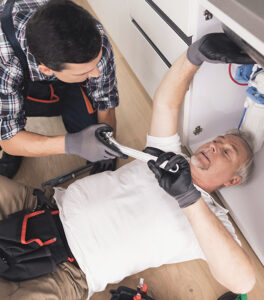Having a stove that won’t turn off can be a frustrating and potentially dangerous problem. Whether you have an electric or gas stove, it’s important to address this issue promptly to avoid safety hazards. A stove that won’t turn off can lead to overheating, gas leaks, and even carbon monoxide poisoning. In this article, we will explore the common causes of a stove that won’t turn off and provide guidance on how to troubleshoot and fix the issue.
Key Takeaways
- A stove that won’t turn off can be a serious safety hazard.
- Common causes include electrical issues, malfunctioning thermostats, faulty ignition switches, defective gas valves, and dirty burners and igniters.
- Checking the wiring and circuit breakers can help identify electrical issues.
- Testing and replacing a malfunctioning thermostat can solve the problem.
- Troubleshooting and repairing a faulty ignition switch may also be necessary.
Common Causes of a Stove that Won’t Turn Off
There are several common reasons why a stove may not turn off. Electrical issues, malfunctioning thermostats, faulty ignition switches, defective gas valves, dirty burners and igniters, and overheating are some of the most common culprits. Electrical issues can occur due to faulty wiring or problems with the circuit breakers. Malfunctioning thermostats can cause the stove to stay on because they fail to regulate the temperature properly. Faulty ignition switches may prevent the stove from turning off even when the knob is in the off position. Defective gas valves can cause gas leaks and keep the stove running continuously. Dirty burners and igniters can also interfere with the proper functioning of the stove. Lastly, overheating can occur due to a malfunctioning thermostat or other internal issues.
Electrical Issues: Checking the Wiring and Circuit Breakers
If you suspect that an electrical issue is causing your stove to stay on, it’s important to check the wiring and circuit breakers. Start by unplugging the stove from the power source and inspecting the wiring for any signs of damage or loose connections. If you notice any issues, you may need to replace or repair the wiring. Next, check the circuit breakers to ensure they are not tripped. If a breaker is tripped, reset it and see if that resolves the problem. If the issue persists, it’s best to consult a professional electrician to diagnose and fix the electrical problem.
Malfunctioning Thermostat: How to Test and Replace It
A malfunctioning thermostat can cause a stove to stay on because it fails to regulate the temperature properly. To test if the thermostat is the issue, turn off the stove and disconnect it from the power source. Remove the thermostat cover and use a multimeter to test for continuity. If there is no continuity, it means that the thermostat is faulty and needs to be replaced. To replace the thermostat, disconnect the wires from the old thermostat and remove it from its housing. Install the new thermostat by connecting the wires according to the manufacturer’s instructions. Finally, replace the thermostat cover and test if the stove turns off properly.
Faulty Ignition Switch: Troubleshooting and Repairing
If you suspect that a faulty ignition switch is causing your stove to stay on, you can troubleshoot and repair it yourself. Start by turning off the stove and disconnecting it from the power source. Remove the control panel cover to access the ignition switch. Inspect the switch for any signs of damage or loose connections. If you notice any issues, tighten any loose connections or replace the ignition switch if necessary. To replace the ignition switch, disconnect the wires from the old switch and remove it from its housing. Install the new switch by connecting the wires according to the manufacturer’s instructions. Finally, replace the control panel cover and test if the stove turns off properly.
Defective Gas Valve: Signs and Symptoms to Look Out For

A defective gas valve can cause a stove to stay on and lead to gas leaks, which can be extremely dangerous. Signs of a defective gas valve include a strong smell of gas, hissing sounds near the stove, or difficulty turning off the stove. If you suspect a faulty gas valve, it’s important to take immediate action. Turn off the gas supply to the stove and contact a professional technician to inspect and replace the gas valve if necessary. Gas leaks can be life-threatening, so it’s crucial to prioritize safety and seek professional help.
Dirty Burners and Igniters: Cleaning and Maintenance Tips
Dirty burners and igniters can interfere with the proper functioning of a stove and cause it to stay on. To clean the burners, remove them from the stove and soak them in warm, soapy water. Use a brush or sponge to scrub away any grease or debris. Rinse the burners thoroughly and allow them to dry completely before reinstalling them. To clean the igniters, use a soft brush or toothbrush to remove any dirt or residue. Be careful not to damage the igniters while cleaning them. Regular maintenance is key to keeping your burners and igniters clean and functioning properly.
Overheating Issues: How to Prevent and Fix Them
Overheating can occur due to a malfunctioning thermostat or other internal issues with the stove. It’s important to address overheating promptly as it can lead to safety hazards such as fires or damage to the stove. To prevent overheating, ensure that the stove is properly ventilated and not placed near flammable materials. If your stove is overheating, turn it off immediately and disconnect it from the power source. Allow it to cool down completely before inspecting for any internal issues. If you are unsure how to fix the problem, it’s best to consult a professional technician who can diagnose and repair any internal issues causing the overheating.
Safety Precautions: Dealing with Gas Leaks and Carbon Monoxide
Dealing with a stove that won’t turn off can be dangerous, especially when it involves gas leaks and carbon monoxide. Gas leaks can lead to explosions or fires, while carbon monoxide poisoning can be life-threatening. If you suspect a gas leak, turn off the gas supply to the stove immediately and open windows and doors to ventilate the area. Do not use any electrical devices or open flames, as they can ignite the gas. Leave the area and contact a professional technician to inspect and repair the gas leak. Carbon monoxide is a colorless and odorless gas, so it’s important to install carbon monoxide detectors in your home. If you experience symptoms such as headaches, dizziness, nausea, or confusion, leave the area immediately and seek medical attention.
Professional Help: When to Call a Technician for Assistance
While some stove issues can be fixed by following troubleshooting steps, there are times when it’s necessary to call a professional technician for assistance. If you are unsure about how to diagnose or fix the problem, it’s best to seek professional help. Additionally, if you suspect a gas leak or are experiencing carbon monoxide poisoning symptoms, it’s crucial to prioritize safety and contact a professional technician immediately. When choosing a technician, look for someone who is reliable, experienced, and licensed. Read reviews and ask for recommendations from friends or family members to ensure that you choose a technician who can fix the issue safely and effectively.
A stove that won’t turn off can be a frustrating and potentially dangerous problem. It’s important to address this issue promptly and safely to avoid safety hazards such as gas leaks or carbon monoxide poisoning. By understanding the common causes of a stove that won’t turn off and following troubleshooting steps, you can often diagnose and fix the problem yourself. However, if you are unsure or suspect a gas leak or carbon monoxide poisoning, it’s best to seek professional help. Remember to prioritize safety at all times and take action to address the issue promptly.
If you’re dealing with a stove that won’t turn off, it can be frustrating and potentially dangerous. However, there are several possible causes and solutions to this issue. To learn more about diagnosing and fixing this problem, check out this informative article from 911 Appliance Repair. They provide expert advice and step-by-step instructions to help you troubleshoot and resolve the issue with your stove. Don’t let a malfunctioning stove ruin your cooking experience – click here to read the article and get your stove back in working order.
Can the Diagnosing Steps for Stove Issues Also Help in Turning Off the Stove?
Yes, the diagnosing steps for stove issues can also help in turning off the stove. By diagnosing stove issues efficiently, you can pinpoint the problem and safely address it, which may include turning off the stove to prevent potential hazards.
Are the Reasons for a Stove Not Turning On the Same as for It Not Turning Off?
When troubleshooting stove won’t turn on, you may find that the reasons for it not turning on are different from why it won’t turn off. Issues such as a faulty ignition switch or gas supply can prevent it from turning on, while a malfunctioning control panel or sensor may prevent it from turning off.



